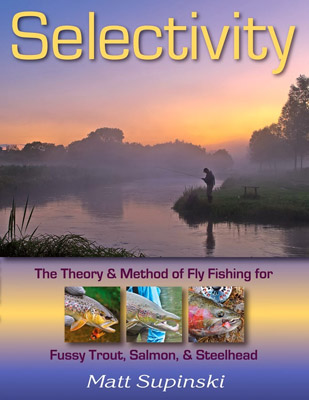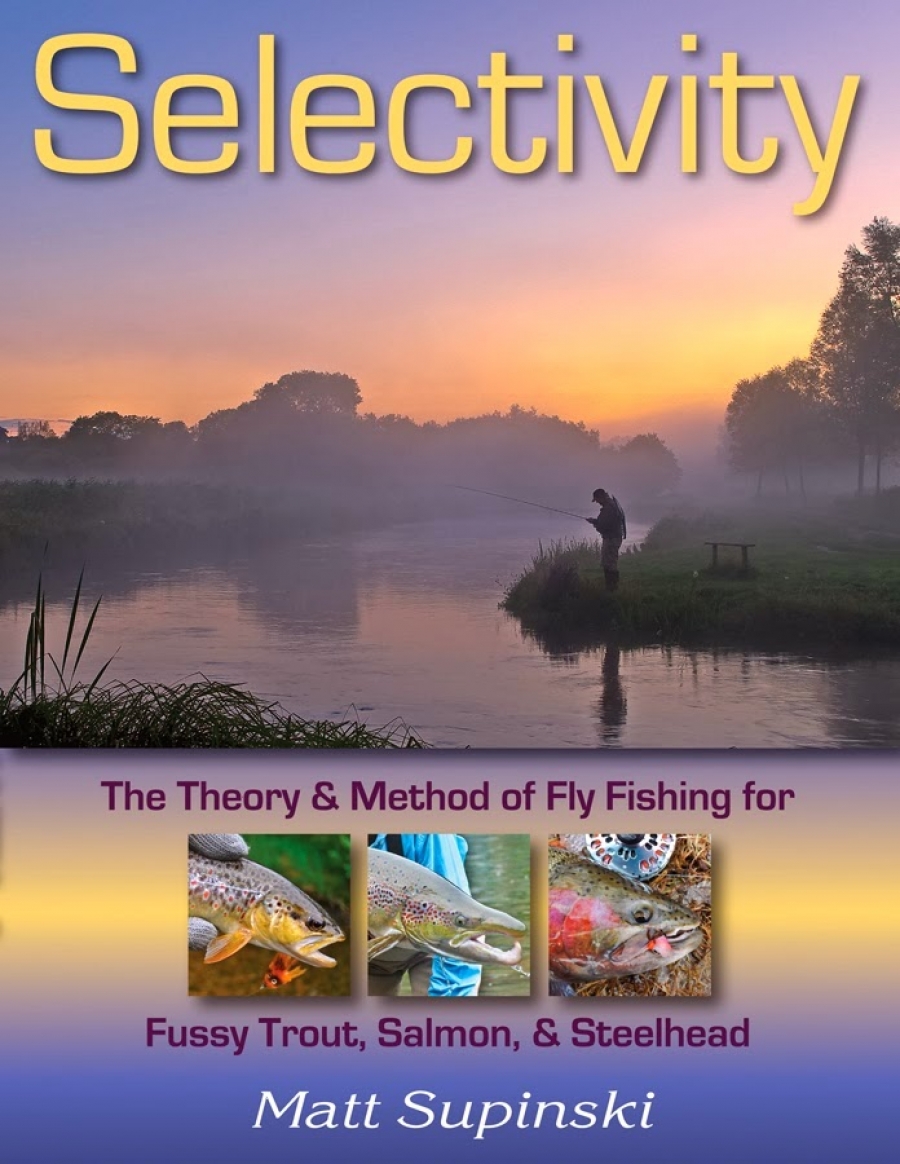Selectivity – The Theory & Method of Fly Fishing for Fussy Trout, Salmon & Steelhead, Matt Supinski, (Stackpole Books, 2014)

The idea of the selective trout and the need for exact-imitation, match the hatch flies took hold on the English chalk streams with Frederick Halford in the late 1800s.
It gained further momentum when a young American university student, Ernest Schweibert, wrote ‘Match the Hatch’ in 1955.
Then came ‘Selective Trout’ by Doug Swisher and Carl Richards in 1983. It made the valid point that hackled flies do not adequately imitate mayflies which float flat on the water surface and their solution was the No Hackle Dun which was effective but not very durable.
The next intensive study of insects that trout feed on was ‘Hatches’ by Al Caucci and Bob Nastasi published in 1975 and their Comparadun proved a far more enduring pattern than No Hackle Dun.
Taking the Comparadun deer hair wing design and attaching it to a curved sedge-type hook to create an emerger was an obvious next step and the most popular version of this is Bob Wyatt’s deer hair emerger.
http://www.tomsutcliffe.co.za/fly-fishing/fly-tying/item/212-bob-wyatts-deer-hair-emerger.html
Wyatt has long espoused presentation rather than imitation and he had a real go at the strict imitationists in his book ‘What Trout want – the Educated Trout and Other Myths’. It was a rebuttal of books like ‘Selective Trout’ and its essence was that trout have tiny brains and can’t learn from experience.
Freestone streams
For the most part I concur with this but they can be selective even on freestone streams which do not have regular and abundant hatches.
In South Africa most mayflies emerge at night, choosing humid nights so that their wings don’t dry out and many species emerge by climbing up stream rocks which makes them less vulnerable to predation.
There is one exception on the freestone streams near Cape Town and that is a daily egg-laying flight of the Choroterpes nigrescens female mayfly. This is difficult to spot with the sun behind you as it always is around 10 a.m. when this occurs. The females fly upstream and dip down to trail their abdomens in the water so that current can pull the eggs free.
It is as though a dinner bell has been rung as a seemingly lifeless stream suddenly boils with jumping fish. This lasts for about half an hour and when the insects disappear, so do the fish. At such times unless you have a #16-18 black parachute or a CDC fly like the Arpo you will hook nothing.
I remember a day fishing the Holsloot stream near Worcester when a fish started rising constantly next to a big rock at the first camp site. I was with Sean Mills and when the trout suddenly started rising I told him to put on an appropriate fly. He persisted with his small deer hair caddis without success until he changed to a black parachute and caught the fish on the next drift. “I had 18 casts and 18 refusals on the caddis pattern”, he said thoughtfully as he released a 14-inch fish.
So there are times when having the right fly can make the difference between success and failure but do fish become more selective as a result of increased fishing pressure – which Wyatt denies?
Animals do learn to adapt positively or negatively to human presence and I have been told that, on heavily fished spring creeks in the USA, trout move in behind anglers to pick up dislodged insects much as an egret will follow cattle to pick up insects disturbed by their presence.
Now a new book has been published which argues against Wyatt’s hypothesis.
Telling anecdotes
Mat Supinski brings half a century of fly fishing experience to bear and provides two telling anecdotes of how trout become more difficult to catch as a result of fishing pressure.
His home stream is a little spring creek in New York state, the Wiscoy. It is a catch and release water which experiences constant fishing pressure on its public section and one day after several hours of fruitless fishing he walked upstream to a private section of the stream. Ducking under the fence he started poaching the private water and instantly started catching fish with the patterns which had been refused on the water downstream which was accessible to the public. No matter what pattern he used, it was taken. However, the more he poached this section, the more his success rate diminished until it was just as difficult as the downstream section.
Later, he fished a beat of the Test where catch and release is not allowed because it is believed that brown trout which have been caught and released become extremely difficult to catch. Once you have caught and killed your limit, you stop fishing and the gillie tells them that fly pattern does not matter “… as long as it’s between a size 12 and a 14.”
They find this to be true, catching fish with ease. Then they bribe the gillie to let them spend a day on the river releasing the fish they catch. “My partner and I, in our youthful greed, caught perhaps sixty-plus big, fat browns. The gillie wrote to us months later and said that the beat was ‘worthless once you Yanks left. Nobody could get those those fish to take a fly and they shut the beat down for the rest of the season mate … shame on you lads’.”
Three categories
He has an interesting take on trout in freestone streams and their feeding habits: It is interesting to stomach-pump a fish and investigate the ingestion process of high-gradient freestone stream trout. Often twigs, plastic/rubber bands and gravel might be found alongside aquatic invertebrates. The trout’s need to quickly intercept and capture food far outweighs to selective process.
Supinski divides trout, salmon and steelhead into three categories: Aggressive/Active, Selective/Reflective and Passive/Dormant.
The trout slashing at the hovering mayflies on the freestone Holsloot are an obvious example of trout in an aggressive/active mode. The selective/reflective trout is the one on the fertile chalk streams in England or a spring creek like the Letort in the USA which sees them drifting for metres below a fly before deciding to take or refuse. The Passive/Dormant fish is the one most of us seem to experience and competition fly fishers spend a lot of time trying to goad such fish into reflexive takes or takes sparked by aggression.
Supinski has no silver bullet when it comes to fly selection and offers no radical new fly designs, but the book is sumptuously produced in heavy glossy paper with an outstanding array of colour photographs. Half of the book is devoted to trout and the rest to steelhead and salmon.
However there is one stream where everyone knows what the silver bullet is, but stealth and delicate presentation still make up, as always, a significant part of the equation.
In revealing the silver bullet, a #14 DDD tied with dark brown deer hair but without tail and hackle. I would, as background, like to refer to a fascinating vignette in Roger Baert’s delightful book, ‘Meandering Streams’.

http://www.tomsutcliffe.co.za/fly-fishing/my-fly-fishing/item/900-platanna-press-releases-roger-baert%E2%80%99s-first-book-%E2%80%98meandering-streams%E2%80%99.html
The chapter is called “The Hopper and the Trout” and in it Roger describes how he and his family were spending a day at the Natal Parks Board trout hatchery on the Umzimkulu River near Underberg. To stop his sons becoming bored Roger suggested that they catch a grasshopper, throw it into the hatchery pond and see what the reaction of the trout was.
This was duly done and the hopper swam to the side of the pond without the slightest response from the dozens of fish which could been seen circling the pond (I have since discovered that grasshoppers do not have lungs but breathe through little holes called spiracles located in the thorax and abdomen which means that while its body is in the water it is slowly asphyxiating.)
The reason for the lack of response, Roger later realised, was that the only food to which the hatchery trout were accustomed was pellets “… and the swimming grasshopper gets top marks as the poorest imitation ever of a trout pellet.”
Roger points out that once trout are stocked and the supply of pellets stops, they quickly adapt to other food sources and, in due course, no longer recognise pellets as food. There is a stream however, filled with wild trout which have never seen a hatchery to which the pellet is a very recognisable prey image.
The Spekboom stream at Highland Run Estate in Lydenberg has trout born and bred in the stream but which weigh in excess of three kilograms. The biomass in the stream does not make them that size – they weigh that much because once a day an employee wonders down the stream throwing in pellets – except when guests are fishing.
http://www.highlandrun.co.za/river.html
In 1994 Tim Rolston, a professional guide, visited Highland Run and subsequently wrote an article, ‘Selectivity, Imitation, Innovation and Ethics’ for that year’s edition of Piscator, journal of the Cape Piscatorial Society.
http://www.inkwaziflyfishing.co.za/
What Tim found was that the hackled DDD was ignored. The successful ‘fly’ had to be slightly soggy so that it floated in the surface film like a pellet and it had to plop into the water like a pellet. If it sank too fast it was ignored and if drag set in the fish spooked. Absolute stealth and delicate presentation were essential and a 14 foot leader was used.
“Imitate the trout’s food. Here that means a plop of a wet, neutral-buoyancy, non-dragging pellet,” Tim wrote.
Those two examples, hatchery trout ignoring a grasshopper because they did not recognise it as food and wild fish that were accustomed to a staple diet of pellets and could only be caught on a fly that looked and behaved like a pellet, are convincing proof that trout do have prey images to which they respond positively. There are, thus, occasions when trout are selective and need a reasonable facsimile of their preferred prey image before they will take.
Do trout become more wary/selective as a result of increased fishing pressure?
Supinski supplies convincing anecdotal evidence even if Bob Wyatt does not find that evidence convincing.
Copies of Supinksi and Wyatt’s books are available from Craig Thom at Stream X/Netbooks in Cape Town.



